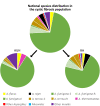Azole-Resistant Aspergillus fumigatus Among Danish Cystic Fibrosis Patients: Increasing Prevalence and Dominance of TR34/L98H
- PMID: 32903400
- PMCID: PMC7438406
- DOI: 10.3389/fmicb.2020.01850
Azole-Resistant Aspergillus fumigatus Among Danish Cystic Fibrosis Patients: Increasing Prevalence and Dominance of TR34/L98H
Abstract
Azole-resistant (azole-R) Aspergillus is an increasing challenge worldwide. Patients with cystic fibrosis (CF) are at risk of Aspergillus colonization and disease due to a favorable lung environment for microorganisms. We performed a nationwide study in 2018 of azole-non-susceptible Aspergillus in CF patients and compared with data from two prior studies. All airway samples with mold isolates from patients monitored at the two CF centers in Denmark (RH, Jan-Sept and AUH, Jan-Jun) were included. Classical species identification (morphology and thermo-tolerance) was performed and MALDI-TOF/β-tubulin sequencing was performed if needed. Susceptibility was determined using EUCAST E.Def 10.1, and E.Def 9.3.2. cyp51A sequencing and STRAf genotyping were performed for azole-non-susceptible isolates and relevant sequential isolates. In total, 340 mold isolates from 159 CF patients were obtained. The most frequent species were Aspergillus fumigatus (266/340, 78.2%) and Aspergillus terreus (26/340, 7.6%). Azole-R A. fumigatus was cultured from 7.3% (10/137) of patients, including 9.5% (9/95) of patients at RH and 2.4% at AUH (1/42), respectively. In a 10-year perspective, azole-non-susceptibility increased numerically among patients at RH (10.5% in 2018 vs 4.5% in 2007-2009). Cyp51A resistance mechanisms were found in nine azole-R A. fumigatus from eight CF patients. Five were of environmental origin (TR34/L98H), three were human medicine-driven (two M220K and one M220R), and one was novel (TR34 3/L98H) and found in a patient who also harbored a TR34/L98H isolate. STRAf genotyping identified 27 unique genotypes among 45 isolates and ≥2 genotypes in 8 of 12 patients. This included one patient carrying two unique TR34/L98H isolates, a rare phenomenon. Genotyping of sequential TR34 3/L98H and TR34/L98H isolates from the same patient showed only minor differences in 1/9 markers. Finally, azole-R A. terreus was found in three patients including two with Cyp51A alterations (M217I and G51A, respectively). Azole-R A. fumigatus is increasing among CF patients in Denmark with the environmentally associated resistance TR34/L98H mechanism being dominant. Mixed infections (wildtype/non-wildtype and several non-wildtypes) and a case of potential additional tandem repeat acquisition in vivo were found. However, similar genotypes were identified from another patient (and outside this study), potentially suggesting a predominant TR34/L98H clone in DK. These findings suggest an increasing prevalence and complexity of azole resistance in A. fumigatus.
Keywords: Aspergillus; azoles; cystic fibrosis; mutation; resistance.
Copyright © 2020 Risum, Hare, Gertsen, Kristensen, Johansen, Helweg-Larsen, Abou-Chakra, Pressler, Skov, Jensen-Fangel and Arendrup.
Figures

References
-
- Abdolrasouli A., Scourfield A., Rhodes J., Shah A., Elborn J. S., Fisher M. C., et al. (2018). High prevalence of triazole resistance in clinical Aspergillus fumigatus isolates in a specialist cardiothoracic centre. Int. J. Antimicrob. Agents 52 637–642. 10.1016/j.ijantimicag.2018.08.004 - DOI - PubMed
-
- Arendrup M. C., Meletiadis J., Mouton J. W., Guinea J., Cuenca-Estrella M., Lagrou K., et al. (2016). EUCAST technical note on isavuconazole breakpoints for Aspergillus, itraconazole breakpoints for Candida and updates for the antifungal susceptibility testing method documents. Clin. Microbiol. Infect. 22, 571.e1–571.e4. 10.1016/j.cmi.2016.01.017 - DOI - PubMed
LinkOut - more resources
Full Text Sources
Miscellaneous

